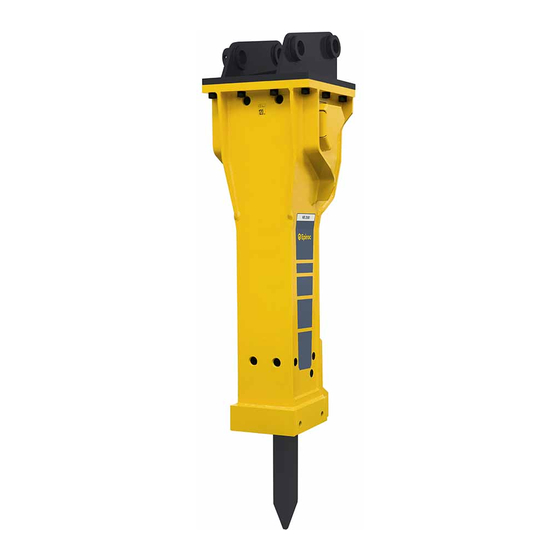
Table of Contents
Advertisement
Advertisement
Table of Contents

Summarization of Contents
Introduction and Manual Overview
About Safety and Operating Instructions
Explains the purpose and scope of the safety and operating instructions manual.
Safety Instructions and Signal Words
Signal Words
Defines the meaning of signal words like Danger, Warning, Caution, and Notice.
Qualification and Intended Use
Intended Use
Describes the proper and specified applications for the hydraulic breaker.
Use Other Than Intended
Lists prohibited operations and their potential consequences.
General Safety Precautions
Protective Equipment
Lists required personal protective equipment for safe operation.
Carrier Precautions
Safety measures related to the carrier vehicle.
Transport Precautions
Safety guidelines for transporting the attachment.
Hydraulic System Safety
Hydraulic Installation Precautions
Safety related to hydraulic system setup and connections.
Special Parts Safety
Safety measures for HP and piston accumulators.
Media/Consumables and Hazard Precautions
Media/Consumables Precautions
Safe handling of hydraulic oil and other consumables.
Explosion and Fire Precautions
Safety measures to prevent explosions and fires.
Hazard Specific Precautions
Electrical Shock Precautions
Safety measures to prevent electric shock.
Falling Stones Precautions
Safety against flying debris and falling objects.
Emissions Precautions
Measures for noise and dust hazards.
Handling, Repair, and Modification Safety
Repair Precautions
Safety guidelines during maintenance and repair.
Modification Precautions
Safety regarding changes to the attachment.
Product Overview and Function
Component Overview
Identifies key parts of the hydraulic breaker.
Breaker Function
Explains the working principle of the hydraulic breaker.
Labels and Identification
Labels and Nameplate
Explains various labels, symbols, and the nameplate details.
Applications and Guarantee
Applications
Lists different fields and types of application.
Guarantee Conditions
Outlines factors that invalidate the guarantee.
Transport Safety
Hoist Tipping and Falling Loads
Safety during lifting and risks of falling loads.
Percussion Unit and Breaker Falling
Risks associated with percussion unit or breaker falling.
Specific Transport Methods
Transport Using a Crane
Procedure for transporting with a crane.
Transport Using a Forklift
Procedure for transporting with a forklift.
Installation and Consumables
Media and Consumables
Details on hydraulic oils, grease, and gas.
Adapter Plate Manufacturing
Guidance on creating adapter plates.
Attaching to Carrier
Mechanical Mounting Aspects
Physical connection steps.
Hydraulic Connections
Connecting hydraulic lines.
Removing from Carrier
Dismantling Hydraulic Connections
Disconnecting hydraulic lines.
Mechanical Disassembly
Physical disconnection steps.
Removing Adapter Plate
Detaching the adapter plate.
DustProtector System
DustProtector Removal
Steps to remove the DustProtector.
DustProtector Installation
Steps to install the DustProtector.
Working Tool Management
Selecting the Right Working Tool
Guidance on choosing the appropriate tool.
Operation Guidelines
Initial Operation and Post-Storage Use
Procedures for first-time use and after long storage.
Pre-Operation Checks
Preparations Before Starting
Essential checks and setup before operation.
Switching Breaker On and Off
Procedures for powering the breaker.
Operational Best Practices
Functional Test
Performing a test before use.
Correct Operation
Proper techniques for effective operation.
Operating Parameters
Advance and Impact Time
How to advance the tool and impact duration.
Temperature Considerations
Adjustments for high and low ambient temperatures.
Prohibited Operations
Prohibited Lifting/Transporting
Unsafe lifting and transport methods.
Prohibited Impacting/Levering
Incorrect use of the breaker for impacting or levering.
Advanced Operation Features
Blank Firing Avoidance
How to prevent or stop blank firing.
Cylinder End Position Precautions
Safety when cylinder is at its limits.
Safety Equipment and Systems
Special Application Safety
Safety for underwater, tunnel, and hot applications.
AutoControl System
Explanation and use of the AutoControl system.
Control Systems
StartSelect System
Setting start/stop behavior.
PowerAdapt System
Function and benefits of PowerAdapt.
Maintenance Overview
Maintenance Schedule
Detailed list of maintenance tasks by frequency.
Hydraulic System Maintenance
Depressurising the Hydraulic System
Safe procedure to release pressure.
Cleaning and Lubrication
Cleaning Procedures
Cleaning the breaker.
Lubrication
Lubrication methods and checks.
Lubrication Systems
Automatic Lubrication (ContiLube II)
Operation and replacement of automatic system.
Manual Lubrication and Filling Devices
Manual Lubrication
Steps for manual lubrication.
Chisel Paste Filling Device
Device for filling paste.
Component Checks
Checking Tensioning Bolts
Procedure for checking bolt tightness.
Checking the Working Tool
Inspecting tool for wear and damage.
Wear Part Inspections
Checking Piston Impact Surface
Inspecting the piston's impact area.
Checking Retainer Bars
Inspecting retainer bars.
Accumulator Checks and Service
Piston Accumulator Pressure Check
How to check piston accumulator pressure.
Piston Accumulator Pressure Management
Release Piston Accumulator Pressure
Releasing pressure from piston accumulator.
Fill/Top-Up Piston Accumulator
Adding gas to piston accumulator.
HP-Accumulator Service
HP-Accumulator Visual Check
Visual inspection of HP-accumulator.
Checking HP-Accumulator Gas Pressure
Checking gas pressure.
System Line and Filter Checks
Checking Hydraulic Lines
Inspecting pipes and hoses.
Hydraulic Oil Filter Check
Maintenance of the oil filter.
Checking Adapter Plate and Breaker Box
Inspecting for cracks and wear.
Troubleshooting Guide
Breaker Does Not Start
Common causes and remedies for startup failures.
Performance Issues Troubleshooting
Slow Operation
Troubleshooting slow hydraulic breaker performance.
Low Impact Force
Diagnosing and fixing low impact force.
Leakage Troubleshooting
Oil Leaks from Ports P and T
Leaks from pressure/tank ports.
Oil Escapes from Working Tool
Leaks from the working tool seal.
Oil Escapes from HP Accumulator
Leaks from the HP accumulator.
Operational Faults Troubleshooting
High Operating Temperature
Troubleshooting overheating issues.
Pressure Line Flailing Violently
Issues with the pressure line.
Repair and Servicing
Sending for Repair
Procedure for sending the attachment for servicing.
Storage Procedures
Hydraulic Breaker Storage
Specific storage instructions for the breaker.
Long-Term Storage (>12 Months)
Procedures for extended storage.
Working Tool and Grease Cartridge Storage
Working Tool Storage
Storing the working tool properly.
Disposal Guidelines
Disposal of Breaker, Hoses, and Oil
How to dispose of main components and fluids.















Need help?
Do you have a question about the HB 2500 and is the answer not in the manual?
Questions and answers